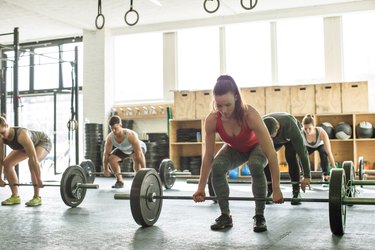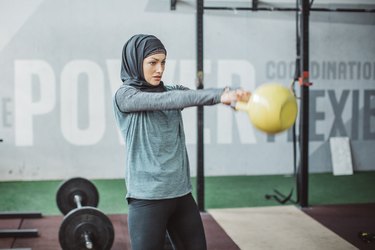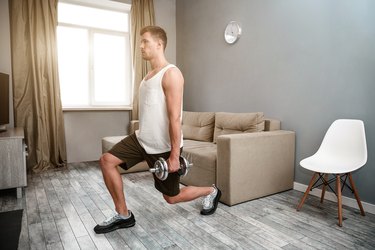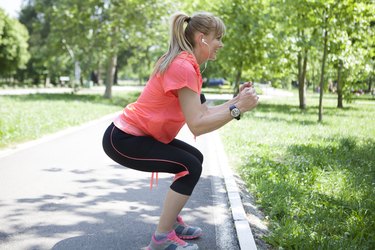
There's a stereotypical scene familiar to many gym-goers: The men are focused on blowing out their biceps and pecs, while the women are all about rounding out their glutes and toning their quads. Of course, that's a huge generalization, but it leads many people to think that women have more lower-body strength than men.
As much as we'd like to think that spending more time by the squat rack automatically means a stronger lower body, the reality is that it depends on a lot of factors.
Video of the Day
Video of the Day
On average, people assigned female at birth (AFAB) don't have more lower-body strength than people assigned male at birth (AMAB) because of key physiological differences. These differences can inform how both people AFAB and those AMAB can train more effectively.
Most sports and exercise science research categorizes people as male and female. Here at LIVESTRONG.com, we believe sex and gender are spectrums and typically use inclusive language to reflect those beliefs. In this article, we're using the language for sex and gender used by the primary sources we cite.
What the Research Says
People AMAB Have More Lower-Body Strength at the Same Body Weight
"Men come out ahead when you're looking at pound-for-pound lower-body strength," Shawn Arent, PhD, CSCS, professor and chair of the Department of Exercise Science at the University of South Carolina, tells LIVESTRONG.com. At the same body weight, on average, people AMAB will have more lower-body strength than people AFAB.
In powerlifting, everyone competes in the same weight classes, but competitors AFAB lift less in the squat and deadlift than competitors AMAB of the same body weight.
In the 90-kilogram (198-pound) weight class, for example, the men's record in the squat is 371 kilograms (around 818 pounds.), compared to the women's record of 273 kilograms (601 pounds.). In the same weight class for the deadlift, the men's record is about 180 pounds more than the women's record.
Studies show some similar results: Male athletes jumped higher than female athletes in a small March 2017 study in Sports (Basel) because they are able to squat deeper and apply more force to the ground.
And a small February 2021 study in the Journal of Functional Morphology and Kinesiology also showed male athletes lifted more in the squat and deadlift and jumped higher than female athletes after adjusting for body weight.
Lower-Body Strength Among People With the Same Lean Mass Is Similar
But when you adjust for lean mass — how much of your weight is lean muscle versus your total body weight — people AMAB and AFAB are very similar in terms of strength capability, Arent says.
The same February 2021 Journal of Functional Morphology and Kinesiology study found no significant difference between women and men in squat or deadlift strength or in jump height when considering lean muscle mass instead of total body weight.
However, we don't divide our body weight up into muscle and non-muscle mass when working out, so generally speaking, people AMAB have more lower-body strength than people AFAB of the same body weight.
3 Factors That Lead to Lower-Body Strength Differences
1. People AFAB Can Train Their Lower Body at a Higher Volume
Generally, "women have less total muscle mass and are shorter in stature, so the barbell needs to travel a shorter distance," explains Ashley Kavanaugh, PhD, CSCS, a sports performance coach at Renaissance Periodization who has researched strength and power in female volleyball athletes.
The farther the weight has to travel, the longer the muscles are under tension, and more muscle fibers are strained over that distance.
"Because the load tends to be lighter and the bar travels a shorter distance [in lifters AFAB, this results] in less neurological and structural fatigue."
As a result, "women lifters can tolerate more volume — more sets and reps," Kavanaugh says. That could mean they may spend more time training these muscles, not necessarily that those muscles are stronger.
2. People AFAB Have a Higher Ratio of Lower-to-Upper Body Strength
Most people AMAB have more upper-body strength than people AFAB: The same February 2021 Journal of Functional Morphology and Kinesiology study found male lifters could lift heavier in the bench press than female lifters with the same body weight. This could be due to differences in the muscle mass distribution in the upper body.
But the key takeaway from this study is that generally, lifters with the same amount of lean muscle mass are a lot closer in strength when it comes to the lower body, no matter their sex assigned at birth.
"So if you're a guy and you see that a woman is weaker than you in the upper body, but similar to you in lower-body strength, your natural thought process may be, 'Women are stronger, pound-for-pound, in the lower body,'" Arent says.
But it might really be that they have greater differences in upper- and lower-body strength.
3. People AFAB Have More Slow-Twitch Muscle Fibers
People AFAB have a greater proportion of type I, aka "slow-twitch," muscle fibers, in their body compared to people AMAB, according to an April 2014 review from Acta Physiologia. Slow-twitch muscle fibers are responsible for endurance-based activities and sustained exercises for a period of time, such as walking and running.
In the lower body, people AFAB have more type I muscle fibers in the vastus lateralis (quad muscle) and tibialis anterior (front lower-leg muscle), for example.
As a result, people AFAB will fatigue less during a long, slow contraction or during longer, lighter sets than lifters AMAB will. The higher concentration of type II, or "fast-twitch" fibers in AMAB means they're more primed for quick, explosive lower-body lifts.
2 Tips for Strengthening Your Lower Body
"It may be true that some women have more lower-body strength than some men, but it almost doesn't matter," says Christine Pellegrini, PhD, assistant professor in exercise science at the University of South Carolina. "Why is one comparing to others?"
The important thing, she says, should be that everyone feels comfortable working out more regularly.
Here are a few ways you can train better and reach your lower-body strength goals.
1. Stop Underestimating Your Strength
"There's plenty of data to suggest women are a lot stronger than they think they are," Arent says.
In fact, people AFAB tend to choose weights that are actually much lighter than what they are truly capable of lifting, according to a small August 2017 study in the Journal of Strength and Conditioning Research.
"They underestimate how strong their lower body is. So if you really push them on it, you see those weights really go up," he says.
That doesn't mean people AFAB should start packing on more weight plates than they can handle, Kavanaugh says. The weight should be challenging, but you should be able to do the exercise with proper form.
2. Prioritize Range of Motion and Technique
Lifting with proper technique and through a full range of motion should be every lifter's focus — regardless of how they identify.
"The number one rule in the weight room should be performing every single repetition with as perfect technique as possible," Kavanaugh says. "Establishing excellent technique not only reduces the lifter's risk of injury but also exponentially increases the amount of strength and muscle a lifter can develop over many years."
Once you've nailed your technique, then you can think about increasing the weight while maintaining perfect form.
- Sports (Basel): "Sex Differences in Countermovement Jump Phase Characteristics"
- Journal of Functional Morphology and Kinesiology: "A Comparison between Male and Female Athletes in Relative Strength and Power Performances"
- Acta Physiologia: "Sex Differences in Human Fatigability: Mechanisms and Insight to Physiological Responses"
- Journal of Strength and Conditioning Research: "Ratings of Perceived Exertion During Acute Resistance Exercise Performed at Imposed and Self-Selected Loads in Recreationally Trained Women"
Was this article helpful?
150 Characters Max
0/150
Thank you for sharing!
Thank you for your feedback!


